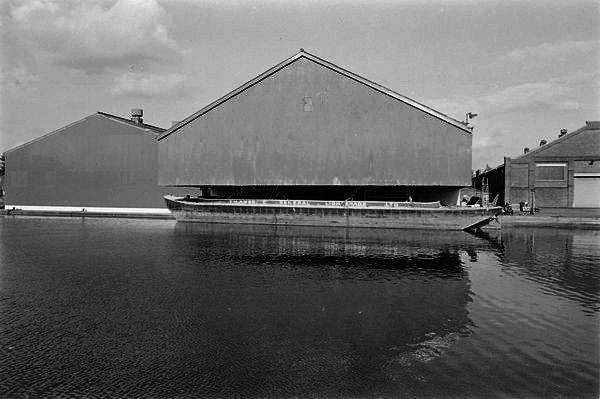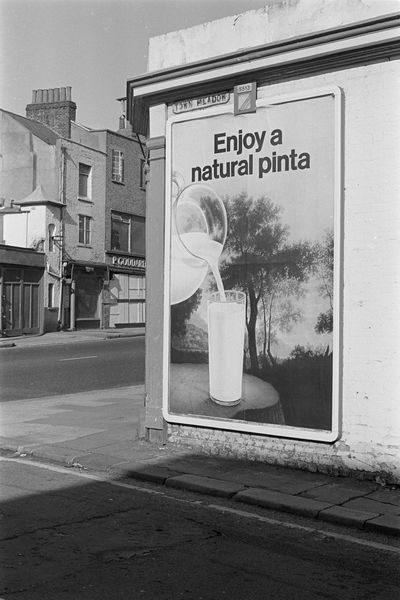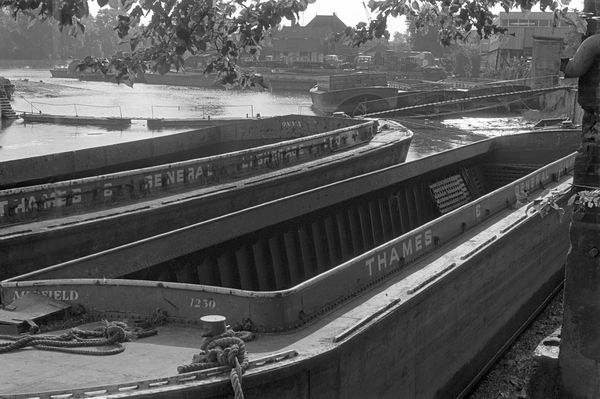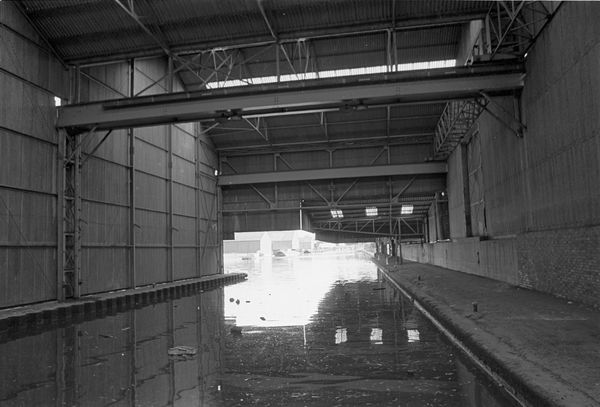
Canal warehouses at Brentford Lock, 1977
When I was young one of our family treats on Bank Holidays and the like was a trip to Kew Gardens. My father was a keen gardener and always had a pair of scissors in his pocket to take the odd cutting, and even we could afford the entrance fee of one old penny. But the highlight for me was never the plants or the picnic on the grass, but the bus journey there from Hounslow, crawling through the busy High St, then through Isleworth to the highlight of Brentford.
We always sat on the top deck, glued to the windows, and chose the right hand side which gave us glimpses of the Thames, but most importantly the gas works. You could smell it long before you reached it, pervading the long and narrow Brentford High St which began at the canal bridge. Then you were in the middle of an industrial landscape, full of odd structures and workers, always stuck in a slow moving traffic jam to give you plenty of time to admire. And if you were fortunate to be in the right place at the right time there was the spectacle of a glowing wall of coke falling to the ground as an oven door was opened. Getting off the bus at Kew Bridge to walk across was always something of an anti-climax.
The gas works was demolished while at I was up north at university, and it was a shock to return a few years later and see the gap where it had been. When I went back in 1977 to photograph, Old Brentford (the eastern parish of the town) was just a different place. Since then Brentford has changed even more, its canal and riverside location which once was industrial becoming a prime location for gentrification, flats with a waterside view attracting a significant premium, though enough remains to make it an interesting area to explore, and a little of the new also has some attraction.
The latest chapter in gentrification is Watermans Park, which I got to know well back in the 1980s and 1990s for the Watermans Arts Centre at its western end, where I helped organise and took part in a number of exhibitions with the photographic group Framework that Terry King and I ran, as well as going to several other shows there. The Arts centre is to be demolished and together with an adjacent office block replaced by expensive riverside flats, while the arts are relocated to a site in the middle of the town where a new 13 storey police station was built in 1966 but vacated by them in 2013, at the Half Acre, where the trolley buses from Hounslow used to turn around and go back.

Town Meadow and Brentford High St, 1977
The police station was Brentford’s third. The first was on the corner of Town Meadow in a building already around a 100 years old and still standing, but a new police station was built in 1869 a little further east on the High St. This rather imposing building was knocked down to build an office block in 1969 , threeyears after the police left for their new site.

Lighters moored alongside the former gas works site on Brentford High St
The gas works was demolished around 1964 and the area became public open space, Watermans Park. Hounslow Council had for some years been attempting to evict the 25 boats moored there – some since the 1960s – to build a £5.4 million marina to gentrify the area and won their legal case last November, with the eight remaining boat owners having to pay over £300,000 in legal costs and given 21 days to move.
The Thames Steam Tug and Lighterage Company was taken established in 1856 it set up a yard on Lots Ait a few yards upstream from here in 1904 which repaired and built barges and tugs for use on the Thames. At that time the company owned 340 barges and five tugs. At its peak the Lots Ait yard employed around 150 men and 2 women.
In 1961 although business was beginning to fall the company still employed over 400 lightermen when it was taken over by the Transport Development Group, and later amalgamated with he General Lighterage Company in the 1960s to form the Thames and General Lighterage Company. Around 1979 this was bought by William Cory Ltd, who moved away from coal and oil transport to waste disposal.
Lighters like this were made from 10mm thick steel, and slowly rust both from the outside and often from the inside, eventually becoming unusable as the steel remaining gets too thin. But there are still quite a few around as this may take a couple of hundred years – and small areas that get too thin can be repaired.

Grand Union Canal, Brentford, 1977
Brentford was where traffic on the canals met the river Thames, with goods being transhipped between large barges like these and narrow boats. The company operated Brentford Dock together with the Great Western Railway, with a line from the main line at Southall which brought Welsh coal, and for some time also had a passenger service with a station on the London Road in New Brentford where you can still see the remains of the bridge which took the line across, and a part of the line further south is now Augustus Close, leading to the private Brentford Dock housing estate with its notices ‘Private Property Residents Only No Public Right of Way’.
As with the railways, it was Dr Beeching, a man deeply in thrall to the road lobby, that did for the river traffic and canals, and in 1963 he recommended that waterborne traffic be moved to the roads; the the Lots Ait yard closed in 1980.
In 2005 the Ait was sold to investors and a retired solicitor, John Watson, decided he could open a new yard there. A new footbridge to the island was built and John’s Boat Works opened there in 2012. Occasionally the island is opened for conducted tours, though I’ve never managed to go on one.
The new Marina will provide moorings for roughly the same number of boats as were alongside the former park, and will be something of an eyesore, with decreased access to the riverside and obscuring the views to Brentford Ait. But while the former moorings paid no fees, the new development will attract a rather wealthier class of boat owners though with significantly less interesting vessels, and will make money for whoever is managing it. A rather better solution, but forward by the boat owners, would have been for Hounslow Council to legalise the moorings, make some improvements and collect sensible fees.
Brentford was another place we sometimes took photography students, and if the tide was right many of them would wade onto the mud bank opposite Lots Ait and sometimes most of the way across. I don’t recall seeing any great pictures that they took, but they seemed to enjoy getting covered in mud.
You can see the pictures here and a few more of Brentford as well as other places in the 1977 section of my London Photographs site, which so far contains pictures from 1974-80.
For a more recent view of Brentford see Riverside Brentford Panoramas and Riverside Brentford, taken in March 2016.
______________________________________________________
There are no adverts on this site and it receives no sponsorship, and I like to keep it that way. But it does take a considerable amount of my time and thought, and if you enjoy reading it, a small donation – perhaps the cost of a beer – would be appreciated.
My London Diary : Buildings of London : River Lea/Lee Valley : London’s Industrial Heritage
All photographs on this and my other sites, unless otherwise stated, are taken by and copyright of Peter Marshall, and are available for reproduction or can be bought as prints.
To order prints or reproduce images
________________________________________________________